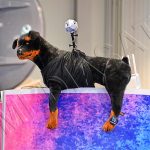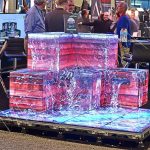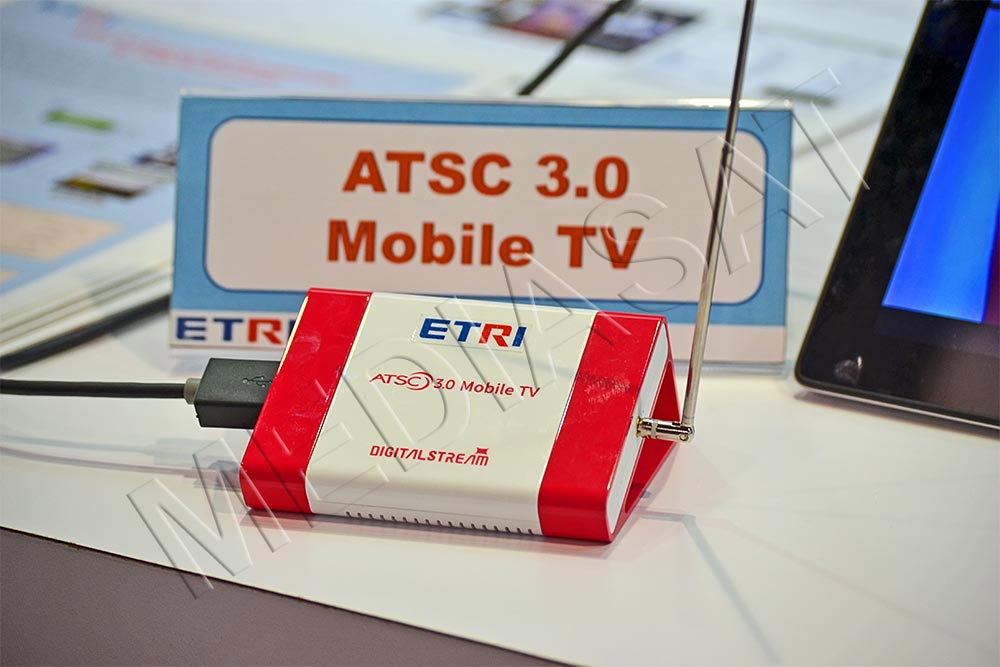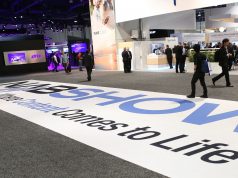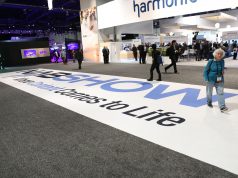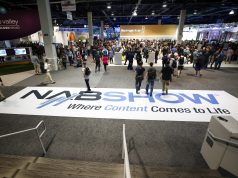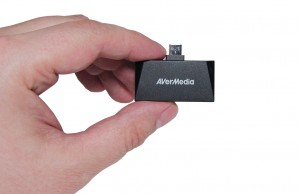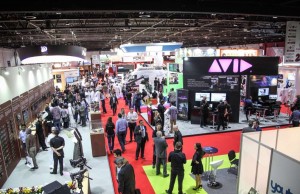End. Read the beginning in the previous articles NAB Show 2017: Monitors and Set-Top boxes and NAB Show 2017: Antennas, Drones and Solutions for Cameramen.
Technology and Interesting Solutions
The solution SAP Clea for Brand Impact by SAP Labs will be duly appreciated by advertisers. After all, the offered solution measures a logo (advertising) frequency on TV, and significantly facilitates statistics collection.
ZPEG announced its software-based technology, which allows optimizing video by 20%, without the need to upgrade/replace encoders. In fact, the technology adjusts and optimizes the H.264/265 codec, working on the section before the codec. Thanks to a 4K video delivery algorithm, it is possible to use half the bandwidth of the channel, thereby reducing video buffering and download time. The algorithm removes from the video “extra” data invisible to the viewer’s eye, without affecting video picture itself.
A new solution by WorldCast Systems should be of interest to TV and radio companies that focus on energy-saving technologies and need to distribute signal in a given area and at minimum expense. A 25-watt solar-powered FM repeater provides signal transmission at a distance of up to 10 km along the line of sight of transmitters. A remote monitoring of equipment via mobile application is supported. The solution, valued at USD 8.000, is coming in July (a pre-order available now).
An ideal solution implementation option is the southern regions of Ukraine, as well as the latitude of Las Vegas, i.e. where there is observed a peak of sun’s activity. A hybrid-power-based transmitter (solar panel + battery) is able to broadcast for up to 10 hours daily and significantly reduces power supply costs. The solution can be used both for broadcasting FM signals and for retransmitting satellite TV signals. And the set of several repeaters can significantly expand the broadcasting area. The FM transmitter works at a frequency of 87.5-108 MHz, and the satellite receiver is designed for the band of 950-2150 MHz (DVB-S/S2), supplied with a relevant “dish”.
At the stand of Korean companies, the ETRI Institute (Electronics and Telecommunications Research Institute) presented a prototype ATSC 3.0 Mobile TV (coming by this year-end), as well as showed a CL-AR3000 professional receiver.
The Mediaexcel’s stand presented a line of solutions for the ATSC 3.0 standard under the Aircode brand. The Korean developers are looking forward to occupying a niche on the UHDTV market in the US just in 2018. The product line includes Signal&ESG, IP Mux, Stream Monitoring and Closed Caption Encoder. The solutions were successfully implemented in Korea by operators like KBS (Korea Broadcasting Systems, the largest terrestrial broadcasting operator) and RAPA (Korea Radio Promotion Association) in 2016. Signal&ESG facilitates the operators’ transition to a next-generation broadcasting in the ATSC 3.0 standard and offers new monetization options due to using a hybrid network model (4K/8K, UHD).
IP Mux is designed for a simultaneous reception and multiplexing of each package in the stream and further transmission to exciter and other devices. Closed Caption encoder converts HDTV data to 4K/UHD in real time and transmits signal after that.
Texas Instruments presented its new LMH1297 chip (12G/6G/3G/HD/SD) for IP video equipment. Despite its small size (only 5×5 mm), the innovation provides signal transmission via IP/SDI networks at a distance of at least 75 m for 12G, 120 m for 6G, 200 m for 3G and 300 m for HD.
Content Security Solutions
In view of a growing number of pirate platforms over the Internet that distribute video and audio, the content security solutions are of particular interest. So, the ECHOTAG solution implements a technology of inserting “digital marks” (watermarks) into audio tracks, broadcasted by radio stations or run as soundtracks in video streams. The solution is suitable for those operators who are eager to monetize their content. After all, contacts of subscribers who watched video or listened to audio broadcasts are of important interest to advertisers. So, EchoMETER allows monitoring user activity and collecting statistics. EchoAD adds watermarks to the broadcast content, received via mobile devices. At the same time, users not only “share” this content with their interlocutors and other subscribers, but also are consumers of this advertising. EchoQUIZ and EchoSURVEY allow adding various polls or surveys to audio tracks, as well as collecting feedbacks from users who take part in these polls. As a result, all user actions are monitored, and the collected statistics facilitates the most effective “distribution” of advertising to interested subscribers and advertised products or services specifically for each broadcast.
Instead of conclusion or ATSC vs DVB-Tx…
Observing the introduction of the DVB-T2 standard in Europe and especially in Ukraine, there arises a question, whether the selected option of “digitizing” broadcasts is suitable for broadcasters and consumers, if the system has not yet been put into commercial operation. The idea came after monitoring activities of broadcasters, producers and developers in countries of the ATSC standard implementation.
Let us recall that ATSC appeared to replace the analog NTSC standard in the USA in mid-2009; in late summer 2011, NTSC was discarded by Canada, at the end of 2012 – by South Korea, and at the end of 2015 – by Mexico. Despite the prevalence of ATSC in the USA, its updated version ATSC 3.0 proved so attractive and universal that Korea is actually about to start mass commercial broadcasting in this standard, and even earlier than the USA does.
Indeed, the US broadcasters are interested in new features of ATSC 3.0. It is no secret that this digital terrestrial broadcasting technology may excite an interest of other countries, both the undecided and “ahead of the curve” ones (in terms of introducing new technologies). The main catalysts for introducing ATSC 3.0 are TV equipment manufacturers (mainly Samsung and LG), as well as broadcasters. The latter seem to have measured the potential and prospects of ATSC 3.0 in terms of content (advertising) monetization and targeting. Not least thanks to receiving equipment developers’ introducing technologies like HDR, HFR and high resolution (4K/8K).
While the USA and Korea are planning to use 6 MHz for a radio channel, other countries may prefer 7 or 8 MHz. For sure, ATSC 3.0 is not quite compatible with the ATSC 1.0 version, so broadcasters and consumers will have to purchase and install new hardware, but this is not a key problem. According to forecasts, Korea will broadcast signal in the 4Kp60 format, while the USA will broadcast it in the 1080p60 (for the main video) and 720p60 (for mobile video) ones.
As for the broadcast content security, some experts believe that as a matter of ATSC broadcasting experience, the encryption schemes were incapable to prove their absolute reliability, being “neutralized” with due time. Therefore, instead of DRM (Digital Rights Management), it is advisable to use “watermarks”, which do not protect the content itself from illegal distribution, but allow content owners to monitor video content distribution by integrating video tags into the video stream (for example, under the steganography principle).
The important, and one of the important functions of digital broadcasting in the United States, Japan and other countries suffering from frequent natural disasters (hurricanes, tsunamis, etc.), is an emergency alert system (including accidents at industrial plants, on auto- and railroads, while transporting dangerous goods). EAS (Emergency Alert System) can find application in many countries of the world as a system of rapid warning about any emergency (recent weather situations in the CIS countries are the very proof of this). After all, since the Soviet times, we still have a mass alert system like radio sets (as of the end of 2015, there were over 1 million of them in almost 7 thousand localities of the country). This wired radio network, owned by the Ukrtelecom, broadcasts the First Radio Show of the National Radio Company of Ukraine and emergency alerts when required. And, the owner does not seem to refuse them, in the light of increasing a subscription fee up to 20 hryvnias from 01/05/2017. However, new buildings do not have them installed…
EAS, if necessary, will “wake up” your TV receiver, radio receiver or “cellular” (both stationary and mobile), and will transmit a relevant message/signal. Moreover, the system should work even in case of failure of transmitting TV and radio towers (since a hybrid signal delivery model is applied). And thanks to the geolocation system, the notification can be spread in a strictly specified area, and not in the whole region or state. ATSC 3.0 provides for peak network congestions (both broadband and cellular). And the ready-made solutions supporting ATSC 3.0 have been presented by certain manufactures since the beginning of 2017 (for example, LG). An illustrative example is Korea, represented by its stand at the NAB Show. By the end of 2017, 70% of Korean households will be able to receive ATSC 3.0 signals. Such activity in introducing “new digital” is due to the coming Winter Olympic Games in Korea in 2018 and the relevant government “supervision”.
Since ATSC 3.0 is not compatible with old ATSC 1.0, the US broadcasters and operators will have to replace a lot of operating transmitters, and “supply” population with new receiving equipment. This will not take one day, and, probably, one month. After all, it is unlikely that somebody would leave certain territories without any TV signal coverage. Meanwhile, the US broadcasters have only one way out of keeping the old (ATSC 1.0) and new (ATSC 3.0) transmitting hardware operational. There is observed a similar situation with Ukrainian broadcasters, who have to support the simultaneous operation of “analog” and “DVB-T2 digital”, paying for all transmitters. While the population is not very active in buying DVB-T2 tuners and is waiting for the next “Z” hour of the analog broadcasting cut-off under the international agreement “Geneva 2006”. But this is unlikely to happen before next year, although the deadlines have been already missed. A free frequency availability problem does exist even in the USA, and given the tightened frequency spectrum and limited budgets of many companies, the operators will have to “do their best” to place several transmitters on a single transmitting tower. Although due to
“sharing” costs for servicing joint (with other companies) transmitting equipment, the company will manage saving money. And the results can be seen a year after, i.e. at the NAB Show 2018.



